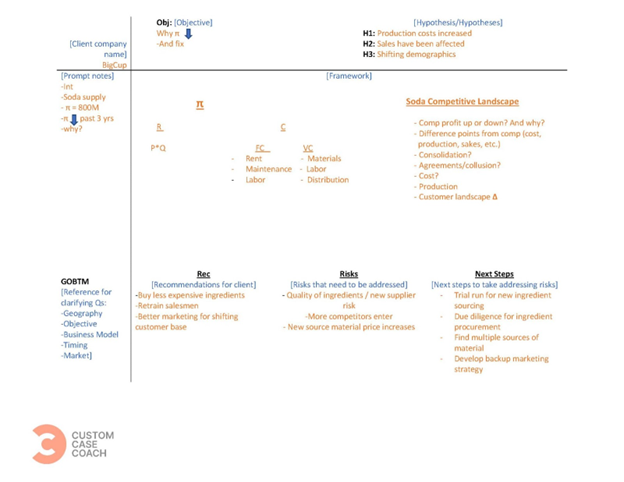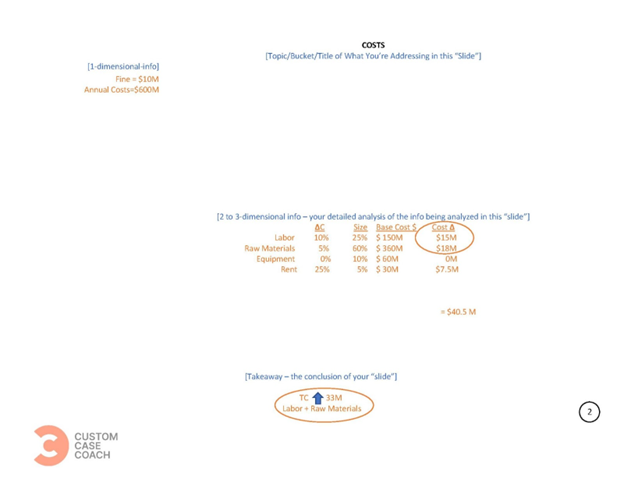So, you’ve got your sights set on a consulting career, huh? You probably know that one of the biggest hurdles you’ll face is the consulting case interview. Consulting firms love using these interviews to put your problem-solving chops and communication and analytical skills to the test. But let’s be honest, prepping for a case interview can feel like climbing Mount Everest. Fear not, my friend! I’ve whipped up the ultimate consulting case interview cheat sheet to help you crush that interview like a pro. I’ve gone an extra step for you and included case interview examples with solutions too so you can prepare like a pro.
Understanding the Consulting Case Interview
Ah, the consulting case interview – the make-or-break moment for aspiring consultants. In this unique interview format, you’ll be thrown a business problem and tasked with solving it. Get ready to ask those clarifying questions, dissect the issue, and lay out your top-notch recommendations.
The whole point of a consulting case interview is to put your critical and creative thinking, communication skills, and grace under pressure to the test. You’ll be judged on how well you can structure your analysis, pinpoint the crux of the matter, and whip up a logical, actionable solution. So, buckle up and bring your A-game!
The Importance of Preparation
Preparing for a case interview is essential if you want to succeed. The more you practice, the more comfortable and confident you will become. You should start by familiarizing yourself with the different types of case interviews and the frameworks that are commonly used. You should also practice solving case interviews and develop your own approach and style.
It is important to remember that the consulting case interview is not just about getting the right answer. It is also about demonstrating your problem-solving skills, your ability to work in a team, and your communication skills. You should practice presenting your ideas clearly and concisely, and you should be prepared to defend your recommendations.
The Consulting Case Interview Cheat Sheet
To help you prepare for your consulting case interview, I’ve put together a cheat sheet that includes a casing template sheet for you to use during your case interview as well as a breakdown of the key stages in a case interview.
Remember, this is a tool, so use it in a way that best suits your needs and style.
When navigating the case interview, you should have 3 types of sheets: Your main sheet (page 1), your math/calculations sheet and your secondary sheets (page 2 onwards).
Main Sheet: Used at the start of your case. Contains the prompt notes, the objective, your framework, and any hypotheses you may have. You will also come back to this sheet at the end of the case to make your final recommendation.
This sheet should never be out of sight. If you are right-handed, put it to your right side when moving on. If you are left-handed, put it to the left.
Math/calculations sheet: This sheet is used for any calculations you have to conduct. Keep in mind, this sheet is not where you necessarily organize your math (create the formula). Rather, this is where you do your long addition, long division, your chaotic scribbling etc. The point of this sheet is to allow you to keep your other sheets clean.
Secondary sheets: These sheets are used during the case. You should use secondary sheets between the framework and the final recommendation stage of the case. In principle, one sheet should be used per section of the case. So, you may have 1, 2, 3, or even 4 secondary sheets in any given case, based on how many phases/sections the case contains.
How to organize and use your sheets: Keep your sheets organized by placing the first sheet with the framework and objective in sight, the math sheet aside, and tuck each subsequent secondary sheet under the previous one. This organization method helps you work through the case more effectively.
The consulting case interview cheat sheet - Page 1


- Listen to the prompt: Take notes on the left side of your sheet, capturing the most important information using keywords or phrases, and shorthand.
- Resynthesize the prompt: Reiterate the prompt back to the interviewer in your own words, summarizing the most important information.
- Write down the company name and objective: As soon as you have the company name and objective, write them down at the top left and top center of your sheet, respectively.
- Ask clarifying questions: Understand the situation and narrow the scope of the case by asking questions about context, business model, objective, etc. Use the GOBTM acronym (Geography, Objective, Business model, Timing, and Market) if you’re stuck.
- (Optional) Write down initial hypotheses: If you have initial views on the case, you can note them down on the upper right side of your sheet (H1, H2, H3).
- Request time to gather your thoughts: Ask the interviewer for a couple of minutes to work on your framework.
- Develop and pitch your framework: Spend the requested time to create your framework, then present it to the interviewer.
- Proceed with the case: If you are in a candidate-led case, demonstrate case leadership by driving the case and asking questions. If you are in an interviewer-led case the interviewer will most likely navigate you to the next section of the case.
Throughout the case, ensure that you stay organized, maintain a clear objective, and adapt your approach as needed.
The consulting case interview cheat sheet - Page 2 (and onwards)


In an interviewer-led case, you’ll be asked questions and must respond accordingly. Whether the case is candidate-led or interviewer-led, it’s crucial to create additional sheets of paper to guide the case. Each time a new topic or section is introduced, use a new sheet. This helps you stay organized.
Each sheet should have a title summarizing the focus of that section. As information is given visually or verbally, record what’s relevant. If data is one-dimensional, write it on the left side. If it’s multi-dimensional, create a table to organize the data.
Capture the information quickly and if you miss something, make a note to clarify with the interviewer later. Organizing the data is crucial for figuring out where to go next. Also, use a separate sheet for messy math calculations.
When reaching a conclusion for a section, write it at the bottom of the sheet.
- Create additional sheets for each case section: As you move on to new topics or themes within the case, use a new sheet of paper to maintain organization and clarity.
- Organize your sheets effectively: Each sheet should have a title that summarizes the section you are working on. This will help you stay focused on the task at hand.
- Capture and categorize information: Information can come in two forms, visual or verbal. Write down relevant and important information as it comes to you. For one-dimensional information, write it on the left-hand side of the sheet. For multidimensional information, create a table to keep data organized.
- Track conclusions and takeaways: Write mini conclusions at the bottom of each sheet, summarizing the findings of each section. Box any relevant data or calculations.
- Stay organized throughout the case: Keep the first sheet in sight for easy reference, have a separate math sheet, and tuck subsequent sheets under each other. This setup allows for seamless transitions between sections and helps maintain a clear and organized workspace.
- Use page numbers to track progress: Assigning page numbers to each sheet helps you keep track of the different sections of the case and quickly refer back to previous findings.
General Tips and Tricks
To give you a leg up in acing your consulting case interview, I’ve put together a few handy tips and tricks to keep in mind during the big day:
- Listen carefully to the interviewer’s instructions and ask clarifying questions if necessary.
- Take time to structure your analysis and to identify key issues.
- Use my consulting case interview cheat sheet to organize your thoughts and to present your ideas.
- Be confident and articulate when presenting your ideas.
- Be prepared to defend your recommendations and to consider alternative solutions.
Business case interview examples
To get you ready for your consulting case interview, I’ve assembled a few Business case interview examples that might pop up when you’re in the hot seat:
- How would you approach a market sizing problem for a new product?
- What are the key drivers of profitability in the airline industry?
- How would you analyze the customer experience for a retail store?
- What are the key factors to consider when pricing a new product?
- How would you optimize the operations of a manufacturing plant?
General Case Interview Examples with Solutions


To aid in your preparation for the consulting case interview, I’ve put together a few General Business case interview examples along with their solutions.
Example 1
A retail company is considering expanding its product line to include a new line of clothing. What factors would you consider when making this decision?
Solution:
When making a decision about expanding the product line, some of the factors to consider include market demand, competition, cost of production, and potential profits. You would need to analyze the target market for the new product line, the competitive landscape, and the potential costs and revenues associated with the new product line.
Example 2
A pharmaceutical company is considering launching a new drug. How would you assess the potential profitability of this new drug?
Solution:
When assessing the potential profitability of a new drug, some of the factors to consider include market demand, pricing, production costs, and competition. You would need to analyze the size of the target market, the competitive landscape, and the potential costs and revenues associated with launching the new drug.
Marketing Case Interview Case Interview Examples with Solutions


Marketing case interviews are used to test your ability to analyze a marketing problem and to develop a strategic recommendation. Here are some marketing Business case interview examples:
Example 1
A restaurant chain is considering launching a new menu item. How would you assess the potential success of this new menu item?
Solution:
When assessing the potential success of a new menu item, some of the factors to consider include market demand, pricing, production costs, and competition. You would need to analyze the size of the target market, the competitive landscape, and the potential costs and revenues associated with launching the new menu item.
Example 2
A consumer goods company is considering launching a new product. How would you develop a marketing strategy for this new product?
Solution:
When developing a marketing strategy for a new product, some of the factors to consider include the target market, the competitive landscape, and the marketing mix. You would need to analyze the needs and preferences of the target market, the strengths and weaknesses of the competition, and the optimal price, promotion, and distribution channels for the new product.
Operations Case Interview Examples with Solutions


Operations case interviews are used to test your ability to optimize a process or a system. Here are some operations Business case interview examples:
Example 1
A manufacturing company is experiencing high scrap rates in its production process. How would you identify the root cause of this problem and develop a solution?
Solution:
When identifying the root cause of high scrap rates, some of the factors to consider include the production process, the equipment, the materials, and the personnel. You would need to analyze the different steps in the production process, the quality of the materials, the maintenance of the equipment, and the training and supervision of the personnel.
Example 2
A logistics company is experiencing high transportation costs. How would you optimize the transportation network to reduce costs?
Solution:
When optimizing the transportation network, some of the factors to consider include the shipping routes, the modes of transportation, the scheduling, and the capacity. You would need to analyze the different shipping routes, the costs and benefits of different modes of transportation, the optimal scheduling of shipments, and the capacity constraints of the transportation network.
How to Ace Your Consulting Case Interview
To ace your consulting case interview, you need to be well prepared, confident, and articulate.
- Practice, practice, practice. The more you practice, the more comfortable and confident you will become.
- Familiarize yourself with the different types of case interviews and the frameworks that are commonly used.
- Develop your own approach and style, and be prepared to adapt to different situations.
- Be confident and articulate when presenting your ideas, and be prepared to defend your recommendations.
- Stay calm and focused, and don’t be afraid to ask clarifying questions if necessary.
Conclusion
The consulting case interview can be a challenging and intimidating experience, but with the right preparation and practice, you can ace your interview and land your dream job in consulting. Use the consulting case interview cheat sheet, the Business case interview examples provided, and my course to develop your skills and confidence, and remember to stay calm, focused, and articulate during your interview. Good luck!
Recommended For You
Want to learn how to ace your case interview? Found this article useful? We recommend the following to help you level up and get that offer:










